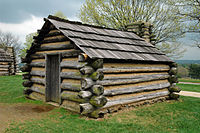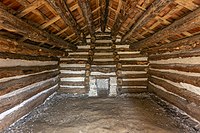Valley Forge National Historical Park
Valley Forge National Historical Park | |
 The National Memorial Arch at the park | |
| Location | Montgomery County and Chester County, Pennsylvania |
|---|---|
| Nearest city | King of Prussia, Pennsylvania |
| Coordinates | 40°05′49″N 75°26′20″W / 40.09694°N 75.43889°W |
| Area | 3,466 acres (1,403 ha)[citation needed] |
| Visitation | 1,645,298 (2022)[1] |
| Website | Valley Forge National Historical Park |
| NRHP reference No. | 66000657 |
| Significant dates | |
| Added to NRHP | October 15, 1966 |
| Designated NHLD | January 20, 1961 |
| Designated NHP | State Park: 1893 National Historical Park: July 4, 1976 |
Valley Forge National Historical Park is the site of the third winter encampment of the Continental Army during the American Revolutionary War from December 19, 1777 to June 19, 1778. The National Park Service preserves the site and interprets the history of the Valley Forge encampment. The park contains historical buildings, recreated encampment structures, memorials, museums, and recreation facilities.
The park encompasses 3,500 acres (1,400 ha)[2] and is visited by nearly 2 million people each year. Visitors can see restored historic structures, reconstructed structures such as the iconic log huts, and monuments erected by the states from which the Continental soldiers came. Visitor facilities include a visitor center and museum featuring original artifacts and providing an introduction to the American Revolution and the Valley Forge encampment. Ranger programs, tours (walking and trolley), and activities are available seasonally. The park also provides over 30 miles (48 km) of hiking and biking trails, which are connected to an extensive regional trails system. Wildlife watching, fishing, and boating on the nearby Schuylkill River also are popular.
Historical encampment

Approximately 12,000 Continental Army troops under George Washington's command were encamped at Valley Forge from December 19, 1777 to June 19, 1778. After British General Howe captured the American capitol of Philadelphia, Washington chose the site for the encampment because it was between the British and the Second Continental Congress in York, as well as supply depots in Reading. At the same time, Valley Forge was far enough from Philadelphia to make a British surprise attack unlikely, but close enough that Continental forces could scout enemy positions and prevent them from foraging the countryside.[3]
The Valley Forge encampment was one of the most trying moments for the Continental Army during the war, but they also used the encampment to retrain and rejuvenate. The shared hardship of the officers and soldiers of the Continental Army and the professional military training provided by Baron Friedrich von Steuben are considered a turning point in the Revolutionary War, which secured the independence of the Thirteen Colonies and the establishment of the United States.
Park history
The Centennial and Memorial Association of Valley Forge[4] was incorporated in 1878 with the purpose of saving, acquiring, and preserving General Washington's Headquarters and surrounding acreage.[5] A large Centennial event was held on June 19, 1878, the 100th anniversary of Washington's Army exiting Valley Forge.[6]
Valley Forge was established as the first state park of Pennsylvania in 1893 by the Valley Forge Park Commission (VFPC) "to preserve, improve, and maintain as a public park the site on which General George Washington's army encamped at Valley Forge."[7] The area around Washington's headquarters was chosen as the park site. In 1923, the VFPC was brought under the Department of Forests and Waters, then incorporated into the Pennsylvania Historical and Museum Commission in 1971.[7]
Valley Forge was designated a U.S. National Historic Landmark in 1961 and was listed in the initial National Register of Historic Places in 1966.[8][9] The area covered by these listings goes outside what was then Valley Forge State Park boundaries to include four historic houses where the Marquis de Lafayette and other officers were quartered.[9]: 6
In 1976, Pennsylvania gave the park as a gift to the nation for the United States Bicentennial. Congress passed a law, signed by President Gerald Ford on July 4, 1976, authorizing the addition of Valley Forge National Historical Park as the 283rd Unit of the National Park System[10] and allocating a budget for essential facilities.[11]
Park Superintendents
State Park Superintendents
- Frederick D. Stone (1893–1895)
- Holstein DeHaven (1895–1898)
- Charles C. Adams (1899–1903)
- A. H. Bowen (1903–1911)
- Col. S. S. Hartranft (1911–1921)
- John S. Kennedy (1921–1924)
- Jerome J. Sheas (1925–1935)
- Gilbert S. Jones (1935–1938)
- Joseph E. Stott (1938–1940)
- E. F. Brouse (1940–1941)
- L. Ralph Phillips (1941–1953)
- Paul E. Felton (1953–1955)
- George F. Kenworthy (1955–1957)
- Wilford P. Moll (1957–1958)
- E. C. Pyle (1958–1966)
- Wilford P. Moll (1966–1969)
- Charles C. Frost, Jr. (1969–1971)
- Horace Wilcox (1971–1976)[12]
National Park Superintendents
- H. Gilbert Lusk (1976–1981)
- Wallace Elms (1981–1990)
- Warren Beach (1990–1996)
- Arthur L. Stewart (1996–2004)[13]
- Mike Caldwell (2004–2011)[14]
- Kate Hammond (2012–2016)[15]
- Steven Sims (2017–2019)[16]
- Rose Fennell (2020–present)[17]
Features and facilities
Visitor center

The park's visitor center includes a museum with artifacts from the American Revolutionary War, an interactive muster roll of Continental soldiers encamped at Valley Forge, ranger-led gallery programs and walks, a story telling program, a visitor information desk, and a store for books and souvenirs. Ninety-minute bus tours of the park and bike rentals are available seasonally. The 19-minute film "Determined to Persevere: The Valley Forge Encampment" is shown in the park's theater next door and is available on the park's website.
Washington's Headquarters

A key attraction of the park is the restored colonial home used by General George Washington as his headquarters during the encampment. Rehabilitation of the headquarters area was completed in summer 2009 and included the restoration of the old Valley Forge Train Station into an information center, new guided tours, new exhibits throughout the landscape, and the elimination of several acres of modern paving and restoration of the historic landscape. Quarters of other Continental Army generals are also in the park, including those of Generals Varnum, Lord Stirling, Lafayette, and Knox.
Reconstructed works and buildings
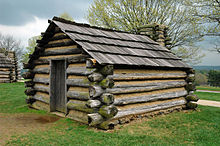
Throughout the park there are reconstructed log cabins of the type thought to be used during the encampment. Earthworks are visible for the defense of the encampment, including four redoubts, the ditch for the Inner Line Defenses, and a reconstructed abatis.
Washington Memorial Chapel
The Washington Memorial Chapel, an inholding of the park, and National Patriots Bell Tower carillon sit atop a hill at the center of the park. The chapel is a functioning Episcopal Church, built as a tribute to Washington.[18] The bell tower houses the Daughters of the American Revolution Patriot Rolls, listing those who served in the Revolutionary War.
Memorial markers
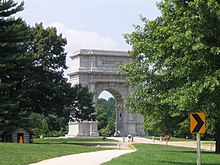
The National Memorial Arch dominates the southern portion of the park and is dedicated "to the officers and private soldiers of the Continental Army December 19, 1777 – June 19, 1778". It was commissioned by Congress in 1910 and completed in 1917. It is inscribed with George Washington's tribute to the perseverance and endurance of his army:
Naked and Starving as they are
We cannot enough admire
the Incomparable Patience and Fidelity
of the Soldiery.
The drive is lined with large memorial stones for each of the brigades that encamped there. Crossing Gulph Road at the arch, the drive proceeds through the Pennsylvania Columns and past the hilltop statue of Anthony Wayne on a horse. More brigade markers line PA Route 23.
Trails
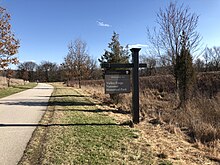
There are over 30 miles (48 km) of hiking, biking, and horseback riding trails within the park, such as the Valley Creek Trail and the River Trail. The main trail is the Joseph Plumb Martin Trail, which consists of a 5-mile (8 km) loop of the park. Portions of regional trails also run through the park, including the Horse Shoe Trail and the Schuylkill River Trail.
Recreation
The many trails in Valley Forge allow for different activities such as jogging, walking and biking. Other activities include horseback riding and canoeing/kayaking. There are three picnic areas located in the park. In addition, Park Rangers dressed in period uniforms are sometimes stationed as the Muhlenburg Brigade Huts, ready to inform visitors about the historic events that happened on the site. The Valley Forge 5-Mile Revolutionary Run is also held in the park every April.
Train station
The Valley Forge Train Station is near Washington's Headquarters. It was completed in 1911 by the Reading Railroad and was the point of entry to the park for travelers who came by rail through the 1950s from Philadelphia, 23.7 miles (38.1 km) distant.[19] The station was restored in 2009 and is used as a museum and information center that offers visitors a better understanding of Washington's Headquarters and the village of Valley Forge.[20] It is constructed of the same type of stone as Washington's Headquarters.[21]
Modern problems
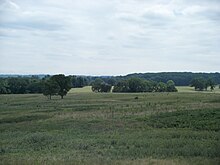
In 2001, a privately held 62-acre (25 ha) tract of land was offered for sale within the park boundaries. Toll Brothers, a real estate development company, purchased it for $2.5 million. The federal government bought it from the developer two years later for $7.5 million.[22]
In 2007, the non-profit American Revolution Center purchased 78 acres (32 ha) of land within the park boundary with plans to construct a conference center, hotel, retail, campground, and museum on the site.[23] The National Parks Conservation Association and local citizens sued Lower Providence Township over the zoning change that enabled this proposal.[24] The two parties agreed to allow the NPS to keep the land, and in exchange, the American Revolution Center was given property in Philadelphia, where it built the Museum of the American Revolution.
An overpopulation of white-tailed deer has resulted in "changes in the species composition, abundance, and distribution of native plant communities and associated wildlife" in the park. In 2008, the National Park Service released a draft deer management plan and environmental impact statement for public review. The intent of the plan was to "support long-term protection, preservation, and restoration of native vegetation and other natural resources within the park."[25] Hunting is prohibited by the legislation that created the park, and action by Congress would be required before it could be sanctioned.[26]
Gallery
- A replica of a cabin at Valley Forge in which soldiers of George Washington's army would have stayed during the winter of 1777–1778.
- Valley Forge Park Entrance Sign from the River trail
- Reconstructed soldier cabin at Valley Forge National Historical Park, Pennsylvania, USA
- Knox Covered Bridge in Valley Forge National Historical Park across Valley Run (creek) near Lord Stirling's Quarters
- Valley Forge Park Visitor Center
- Anthony Wayne statue at Valley Forge, PA
- Valley Forge Memorial Arch in Valley Forge National Park, Valley Forge, PA
- Washington Memorial Chapel (construction started 1903) located within the Valley Forge National Historical Park in Pennsylvania
- Replica cannons in the Artillery Park located east of the parking lot on East Inner Line Drive at Valley Forge National Park
See also
- Freedoms Foundation at Valley Forge
- Kennedy Mansion (Valley Forge)
- List of National Historic Landmarks in Pennsylvania
References
- ^ "NPS Annual Recreation Visits Report". National Park Service. Retrieved July 23, 2023.
- ^ "National Park Service". Retrieved December 28, 2019.
- ^ Prussia, Mailing Address: 1400 North Outer Line Drive King of; Us, PA 19406 Phone: 610 783–1000 Contact. "What Happened at Valley Forge – Valley Forge National Historical Park (U.S. National Park Service)". www.nps.gov. Retrieved December 2, 2024.
{{cite web}}: CS1 maint: numeric names: authors list (link) - ^ "Backstory of Washington's Headquarters". King of Prussia Historical Society. June 23, 2018.
- ^ Treese, Lorett. "The Centennial and Memorial Association of Valley Forge". Valley Forge: Making and Remaking a National Symbol. The Pennsylvania State University Press – via United States National Park Service (NPS).
- ^ Brown, Henry Armitt (1911). "Oration at Valley Forge: The One Hundredth Anniversary of the Departure of the Army of the Revolution From Winter Quarters at That Place". Classic in the Grades – via Google Books.
- ^ a b "Records of the Valley Forge Park Commission (VFPC)". Retrieved October 27, 2006.
- ^ "Valley Forge". National Historic Landmark summary listing. National Park Service. Retrieved January 13, 2010.
- ^ a b Richard Greenwood (November 5, 1974). "National Register of Historic Places Inventory-Nomination: Valley Forge State Park / Valley Forge". National Park Service. and Accompanying six photos, from 1972 and undated
- ^ Valley Forge National Historical Park – Washington Memorial Chapel (U.S. National Park Service)
- ^ Schulze, Richard T. (July 4, 1976). "All Info – H.R.5621 – 94th Congress (1975–1976): A bill to authorize the Secretary of the Interior to establish the Valley Forge National Historical Park in the Commonwealth of Pennsylvania, and for other purposes". www.congress.gov. Retrieved April 28, 2020.
- ^ "Valley Forge National Park – Pennsylvania" (PDF). National Park Service.
- ^ "National Park Service: Historic Listings of NPS Officials (Superintendents of National Park System Areas)". npshistory.com. Retrieved April 28, 2020.
- ^ Smith, Jason. "Valley Forge introduces new superintendent". The Phoenix, Reporter & Item. Retrieved April 28, 2020.
- ^ "Kate Hammond named Superintendent of Valley Forge National Historical Park – Valley Forge National Historical Park (U.S. National Park Service)". www.nps.gov. Retrieved April 28, 2020.
- ^ "Steven Sims Chosen as Superintendent of Valley Forge National Historical Park, Hopewell Furnace National Historic Site – Valley Forge National Historical Park (U.S. National Park Service)". www.nps.gov. Retrieved April 28, 2020.
- ^ "Rose Fennell Named Superintendent – Valley Forge National Historical Park (U.S. National Park Service)". www.nps.gov. Retrieved July 14, 2020.
- ^ "CHAPTER FIVE: The Churches at Valley Forge". Valley Forge National Historic Park. Archived from the original on March 23, 2007. Retrieved October 30, 2006.
- ^ Official Guide of the Railways. New York: National Railway Publication Co., February 1956.
- ^ Petersen, Nancy (January 3, 2007). "A new view of Valley Forge". The Philadelphia Inquirer.
- ^ Train Station
- ^ "Toll Bros: History, Land ... and Battles". Archived from the original on October 8, 2007. Retrieved October 27, 2006.
- ^ "Keep Valley Forge sacred". February 15, 2008.
- ^ "Park Advocates Sue Lower Providence Township in Federal Court to Deny Valley Forge Rezoning". National Parks Conservation Association. December 1, 2008. Retrieved June 14, 2010.
- ^ "White-tailed Deer Management Plan/Environmental Impact Statement, Valley Forge National Historical Park, King of Prussia, PA". Retrieved November 1, 2006.
- ^ "Valley Forge park sets deer hearing". Archived from the original on October 22, 2006. Retrieved October 27, 2006.
External links
- Official website
- Historic American Buildings Survey (HABS) documentation:
- HABS No. PA-6186, "Valley Forge National Historical Park", 102 photos, 5 measured drawings, 18 data pages, 11 photo caption pages
- HABS No. PA-5369, "Jones House", 2 data pages
- HABS No. PA-6720, "Stirling's Quarters", 10 measured drawings
- HABS No. PA-6171-A, "Varnum Headquarters, House", 23 photos, 2 color transparencies, 3 photo caption pages
- HABS No. PA-6171-B, "Varnum Headquarters, Spring House", 6 photos, 1 photo caption page
- HABS No. PA-6713, "George Washington's 1776 Sleeping Marquee", 8 measured drawings
- Historic American Engineering Record (HAER) No. PA-114, "Valley Forge Observation Tower", 10 photos, 6 data pages, 1 photo caption page
- "Determined to Persevere: The Valley Forge Encampment"



